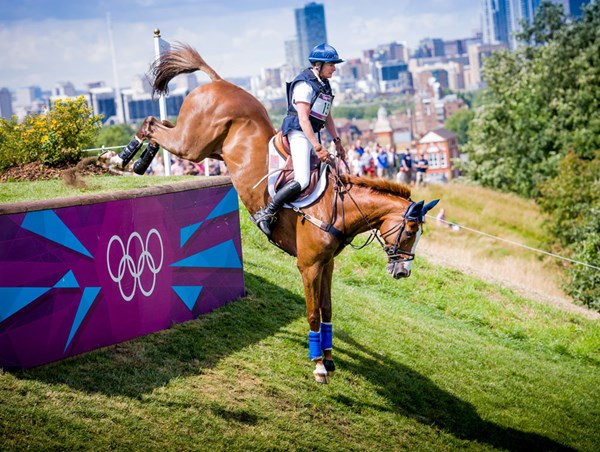
My eventing career, which I dedicated so much time, energy and passion to for more than 30 years, ended abruptly on Saturday, October 6, 2012. I was nearing the finish of the Advanced-level cross-country course at the Morven Park Horse Trials in Leesburg, Virginia, on Veronica, a 10-year-old Dutch Warmblood mare I’d trained to the four-star level. I had already been around once on my 2008 Olympic partner, Mandiba, and he gave me an absolutely fantastic ride inside the time. Veronica and I were having an immaculate round as well until we arrived at a bounce in the woods at the top of a hill just after a gully. As I entered the woods, I slowed way down to give her a moment to adjust to the change from light to dark. Her focus wavered and her footwork became quite scampery. As we came up the other side of the gully, she was behind my leg and her outline was in a bad shape. Now we were three or four strides from the bounce and a collision of bad decisions was occurring within moments between the mare and myself. I reacted with my leg to get her back out in front of me. She shot forward, coming in flat and fast to the bounce.
It was like the perfect storm. The only stride I saw now was the long one. And, as much as I knew better, I was committed to it. I expected her to react more to the bounce, to have a peek and to back off—which would have held her balance and kept us both safe. But the opposite happened: She left the ground for the A element too fast and hollow. I don’t think she ever saw the B element, probably because of the steepness of the hill coupled with her small size—only 16 hands. When she landed over the A element, she was right up against the B element with nowhere to go. She hit above both knees, causing the fastest fall of horse and rider I had ever experienced—so fast that I couldn’t get my arms out in front of me to block my fall.
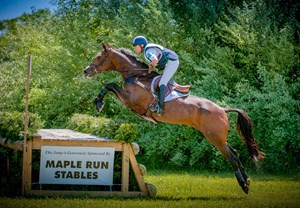
I literally bounced off the top of my head twice and then, for the first time ever in my career, I couldn’t get up. I knew I was in big trouble. I glanced back at Veronica, who was sitting dog style with her front legs splayed far apart, looking stunned. Fortunately, it hadn’t been a rotational fall—the most feared fall in equestrian sport. She had landed on the front of her face and buckled at the neck but didn’t flip over onto her back. A moment later, she got up and I was grateful to see her walk off unharmed.
At that point I began to focus on my own well-being. I have been in a lot of pain over the years from falls and accidents. This was excruciating, unlike any other pain I had experienced. I was lying on the slope with my head pointing downhill. Soon after the first responders arrived, I started getting pins and needles in both arms. Then I totally lost feeling in my arms. Now I was scared. I asked the medic to turn me around so my head would be uphill. Once the backboard was in place, he obliged. I immediately felt some relief and the feeling came back.
I first was taken to the Inova Loudoun Hospital, then transported to the trauma center at Inova Fairfax Hospital in Falls Church, Virginia. The X-rays, CT scans and MRIs determined that the severe blunt trauma to the top of my head caused a ripple effect to my spine and compression damage to the middle of my back, breaking thoracic vertebrae 4 and 5 and shattering T6 and T7 into multiple pieces. I’d also broken several ribs on both sides. Miraculously, I didn’t hurt my head or neck and never lost consciousness.
Deciding to go the conservative route and see if I could heal nonsurgically, the specialists fitted me with a supportive tortoise-shell brace and sent me home that Wednesday. The following Monday, I went to see a thoracic-spine expert, Dr. Lee Riley, at Johns Hopkins University in Baltimore, Maryland. By that point, the angle of my vertebrae had changed, jeopardizing my spinal cord. Dr. Riley said it was like cutting a wedge out of a tree before it falls down. He told me I was one minor misstep from having irreversible spinal-cord damage. We scheduled surgery to stabilize my back for that Thursday.

Anticipating the surgery, I went through a thousand different emotions. When the surgeon told me I would have rods and screws in my back, I understood the magnitude of the situation. He knew I had been a professional athlete my entire life, that it was everything to me and that I wanted to return to eventing. But he didn’t tell me then how much my injury would change things. He knew how much positive energy I’d need for the first three months and that it would have been very damaging to hear my limitations early on. So he just said, “We’ll leave all those discussions for later.”
I went through the surgery, which lasted about seven hours, just fine. For the next few weeks, I had to be more medicated for pain than I ever had before. A lot of angelic people looked after me: my mom, my mother-in-law and many friends, including Marilyn Little, Max Corcoran, Tracy Hewlett, Leslee Gregory and Jacqueline Mars. My husband, David, interrupted his first time as chef d’équipe for Team USA at the Boekelo CCIO*** in Holland to fly home and give his support. I will be forever grateful to everyone who did and continues to do so many things during my recovery.
Long, Painful Recovery
After the surgery, I received in-home physical therapy every day at first and then three times a week for about six weeks. In the beginning of December, Ms. Mars generously flew me to our winter base in Ocala, Florida, where I added massage therapy and Pilates to my rehabilitation regimen. At that time, I was in a back brace that was a bit like traction, pulling down on my hips and up on my neck with a cup for my chin to keep the injury stable.
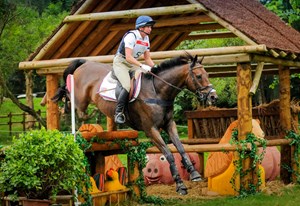
It was a very tough time for me and the people around me. I think I was, generally speaking, fairly upbeat, but I had my low moments. As time went on, though, I actually forgot how bad it was and started to become aware of how lucky I was. This accident cannot compare with any previous injury I’ve sustained. I have perforated a kidney, broken a leg, arm, sternum, both clavicles, shoulder blade, scapula, orbital and jawbone and experienced multiple concussions. But when you hurt your spine, the very part of your body that sustains your quality of life, it’s like nothing else. I tried to become a very good patient, to give the doctor and the people around me the opportunity to do their best possible job for the sake of my recovery. There was a lot of humility to it.
At my three-month checkup, Dr. Riley sat me down for a talk. With the two permanent titanium rods supporting my spine, he said, “you can do whatever you want but cannot get injured because I can’t fix you twice. You can’t fall at speed and hit sideways into something that won’t give.” The two rods are each 11 inches long, going from T1 to T11 and secured to my vertebral processes with 16 3-inch screws. They are there to protect my spine, but if I were to fall against a solid obstacle at 22 miles an hour, my spine would probably break above and below them.
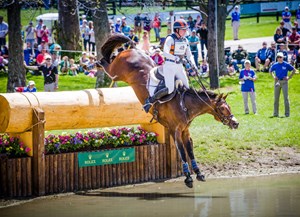
This became a bigger conversation with David, my mom and my family. Eventing was always the perfect match for my passions. I really enjoy high-speed activity and I absolutely love animals, horses in particular. But the conversation became something larger than just my wish to get back to cross-country riding. For me, it became a decision about the people around me. And the risk was too great. In the end, the decision to hang up my cross-country spurs was easy.
By March 2013, I had been in the brace for four months and I was over it. Dr. Riley said that my spine had no arthritis and was staying very aligned, that I was healing in the top one percentile of my class and my pain tolerance was unprecedented. He told me that I was ready to come off the meds and out of the brace—either cold turkey or by weaning myself off it. I was so excited that I reached into my purse for all the different medications I’d been on around the clock and threw them into the trash. I walked out of his office carrying the brace in one hand. It was a cool moment.
Five months after the surgery, I was back in the saddle—and it felt great! My good friend Marilyn Little had been schooling a horse who was very quiet. When she jumped off she told me to get on. So I walked around and then trotted around, then cantered in both directions and it felt pretty good. Then Marilyn encouraged me to jump a fence. I was very grateful to her because it totally changed the way I felt about my potential recovery. I wouldn’t recommend that to someone who does not have the experience that I have, but I have so much muscle memory that it was more comfortable for me to jump than it was for me to drive the car.
I continued to be very weak for a long time. I rode but only for short durations. The Pilates helped me gradually gain strength, mobility and range of motion. I also did some treading water in the pool, which was very good for my lungs and cardiovascular system. And I started walking through the farm every day if the weather was good enough. It became pretty obvious the things I could and could not do that year. For example, I couldn’t drive a golf cart because any bumps in the road would shoot pain up my back. I felt like a tuning fork.
More Big Decisions
I’ve yet to become afraid of any aspect of riding, including horses who are disobedient. I would attribute that to the thousands of hours I’ve spent in the saddle. It’s my most comfortable place and my happy place, where I am most relaxed. I’m not afraid to jump or go fast. But I am certainly more careful in my choices. I’m not going to go aggressively into a situation unless I’m capable of controlling it. So, in addition to my cross-country career being over, I think backing babies is also over.
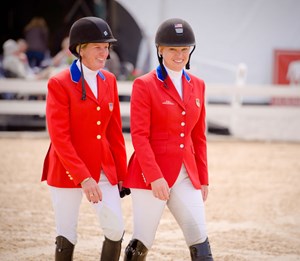
It was so indescribably hard to let go of my event horses. Losing my 2012 Olympic partner, Mr. Medicott, was one of the most heartbreaking experiences of my life. Phillip Dutton now rides him. We matched the rest of my string to other riders, many of them my students. Veronica’s owners, Team Rebecca, LLC, gave her to longtime Team O’Connor student Lauren Kieffer to campaign. In 2014, Veronica and Lauren were the highest-placed U.S. competitors at the Rolex Kentucky CCI****, finishing second overall, and the U.S. Eventing Association named them Mare of the Year and Lady Rider of the Year.
I still have Mandiba in the stable, thanks to his owner, Joan Goswell. Although we had tried to match him with a less-experienced rider, his slipping confidence made it clear that it wasn’t going to work for him. Then I had Marilyn compete him, and his confidence started to increase. He has been a great friend and a wonderful partner for over 10 years. What he will do the rest of his competitive career is unknown, but we have no expectations for him whatsoever.
Throughout my career I haven’t regretted anything except the mistake I made at that particular moment before the accident—and that I didn’t get to say when my career was going to end. I felt that I was riding the best I had ever ridden in my life. Everything was coming around full circle and I was understanding so much about the sport—the connection of all three phases. So I’m regretful but also philosophical. What a great run I have had thanks to amazing horses, owners, staff and all the hundreds of people throughout the decades who were part of my career.
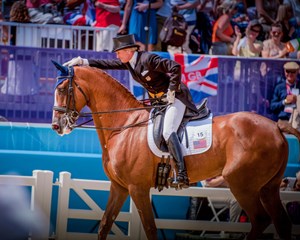
At 57, I’m going through the stage of my life now where I walk down our trophy hallway and see some amazing accomplishments on the shelves. And yet I look forward to the future. I have so many ways to continue to enjoy horses throughout the rest of my life. Next month, I’ll share some of the exciting new directions I’m exploring.
It Could Have Been Worse
In eventing, accidents are a part of life. It’s never a matter of if you’re going to fall cross country; it’s a matter of when. You can get really hurt in any sport that involves speed. Fortunately, the efforts to reduce the risk in our sport have been overwhelming in recent years with the frangible technology, course and building design, etc. My accident is proof that many of these changes make a positive difference, although we still have lessons to learn.
The B element of the bounce jump where we fell did not have a frangible pin. In retrospect, I believe that may have deflated the velocity of the fall and perhaps the outcome would have been quite different.
On the plus side, though, I was wearing two protective vests—my Olympic U.S. Equestrian Federation vest and my Point Two air vest, one on top of the other. There have been plenty of opinions out there that an air vest couldn’t prevent a compression fracture. However, I believe the pressure that the air vest created surrounding my chest cavity may have contained the burst fracture and prevented it from damaging my spinal cord. I also had a great helmet. It is rare in a fall to hit the top of your head like I did, but I did not lose consciousness and did not have a concussion, I think because of my helmet.
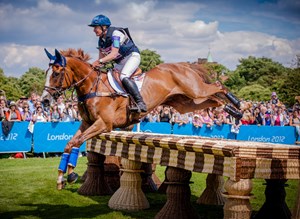
My fitness commitment for the Olympic Games only two months before the accident also really helped. I was at around 10 percent body fat at the Games and was as strong as I had ever been. After breaking my shoulder blade two years previously, I needed to be as strong as I could be to ride Mr. Medicott. Fitness does matter in riding. I am sure this was a positive contributing factor to my being able to walk today.
Finally, the first responders and all the volunteers at the event were absolutely amazing and surely made a difference in my outcome. I never got the chance to thank everyone responsible—I’m not even sure who they were. But I am very grateful to them.
This article originally appeared in the May 2015 issue of Practical Horseman.

